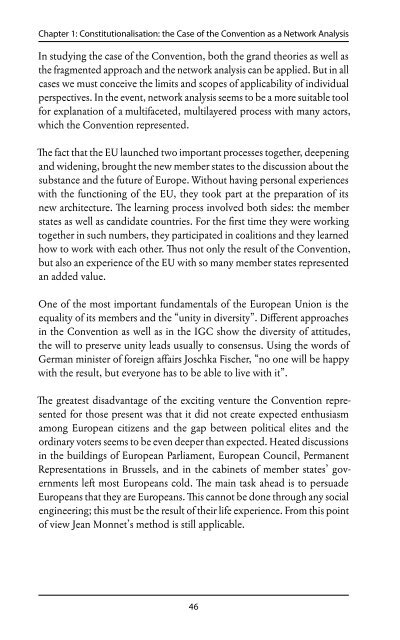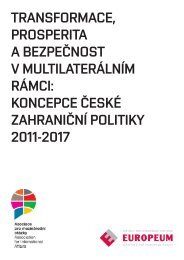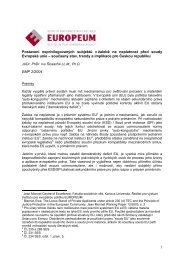eu constitutionalisation - EUROPEUM Institute for European Policy
eu constitutionalisation - EUROPEUM Institute for European Policy
eu constitutionalisation - EUROPEUM Institute for European Policy
Create successful ePaper yourself
Turn your PDF publications into a flip-book with our unique Google optimized e-Paper software.
Chapter 1: Constitutionalisation: the Case of the Convention as a Network AnalysisIn studying the case of the Convention, both the grand theories as well asthe fragmented approach and the network analysis can be applied. But in allcases we must conceive the limits and scopes of applicability of individualperspectives. In the event, network analysis seems to be a more suitable tool<strong>for</strong> explanation of a multifaceted, multilayered process with many actors,which the Convention represented.The fact that the EU launched two important processes together, deepeningand widening, brought the new member states to the discussion about thesubstance and the future of Europe. Without having personal experienceswith the functioning of the EU, they took part at the preparation of itsnew architecture. The learning process involved both sides: the memberstates as well as candidate countries. For the first time they were workingtogether in such numbers, they participated in coalitions and they learnedhow to work with each other. Thus not only the result of the Convention,but also an experience of the EU with so many member states representedan added value.One of the most important fundamentals of the <strong>European</strong> Union is theequality of its members and the “unity in diversity”. Different approachesin the Convention as well as in the IGC show the diversity of attitudes,the will to preserve unity leads usually to consensus. Using the words ofGerman minister of <strong>for</strong>eign affairs Joschka Fischer, “no one will be happywith the result, but everyone has to be able to live with it”.The greatest disadvantage of the exciting venture the Convention represented<strong>for</strong> those present was that it did not create expected enthusiasmamong <strong>European</strong> citizens and the gap between political elites and theordinary voters seems to be even deeper than expected. Heated discussionsin the buildings of <strong>European</strong> Parliament, <strong>European</strong> Council, PermanentRepresentations in Brussels, and in the cabinets of member states’ governmentsleft most <strong>European</strong>s cold. The main task ahead is to persuade<strong>European</strong>s that they are <strong>European</strong>s. This cannot be done through any socialengineering; this must be the result of their life experience. From this pointof view Jean Monnet’s method is still applicable.46Chapter 1: Constitutionalisation: the Case of the Convention as a Network AnalysisBIBLIOGRAPHY:g CHRISTIANSEN, T. (1997), Reconstructing <strong>European</strong> Space: From TerritorialPolitics to Multilevel Governance, in: Jørgensen, K. E. (ed.), Reflective Approachesto <strong>European</strong> Governance (Basingstoke: Macmillan), pp. 51-68.g DEHOUSSE, R. (1997), <strong>European</strong> Integration and the Nation State, in: Rhodes,M., Haywood, P., Wright, V. (eds.), Developments in West <strong>European</strong> politics(New York: St. Martin’s Press)g DOWDING, K. (1995), Model or Metaphor? A Critical Review of the <strong>Policy</strong> NetworkApproach, in: Political Studies, XLIII, pp.136-158g DINAN, D. (1999), Ever Closer Union, (London: Macmillan)g DYKE, R. (2000) Canadian Politics, Critical Approaches(Scarborough: Nelson Learning, 3rd edition)g The Economist, 8-14 November 2003, <strong>European</strong> Union Enlargement,Big brother is still watchingg Euractiv.com, 31 May 2001, Schroeder‘s Europe, A Eurovision song contesthttp://www/<strong>eu</strong>ractiv.com/gci-bin/<strong>eu</strong>rb/gcint…/26671-312?g Euractiv.com, 31 May 2001, Chirac and Jospin launch French debate on futureof EU http://www.<strong>eu</strong>ractiv.com/gci-bin/<strong>eu</strong>rb/cgint…/26671-312?g EUROPEAN CONVETION: Non paper on the re<strong>for</strong>m of EU institutions, The<strong>European</strong> Convention, The Secretariat, CONV 485/03, 15 January 2003,http://register.consilium.<strong>eu</strong>.int/pdf/en/03/cv00/cv00485en03.pdfg EUROPEAN CONVENTION: Preliminary Draft constitutional treaty, The <strong>European</strong>Convention, The Secretariat, Brussels, 28 October 2002g EUROPEAN CONVENTION: Draft Treaty Establishing a Constitution <strong>for</strong> Europe,Submitted to the <strong>European</strong> Council Meeting in Thessaloniki, 20 June 2003g EUROPEAN CONVENTION: Contribution Franco-Allemande à la ConventionEuropéenne sur l‘Architecture institutionelle de l‘Unionhttp://www.constitutional-convention.net/bulletin/archives/000296.htmlg Financial Times, 6 September 2000, Hubert Vedrine, A greater Europe by Re<strong>for</strong>m, p. 2g FOREIGN GOVERNMENT OFFICE UK, “Plain Speaking on Europe”, Edited Speechby FCO Minister <strong>for</strong> Europe, Peter Hain (At the Progress Annual Lecture, ChurchHouse, London, 17 July 2001) http://www.fco.gov.uk/news/newstext.asp?5158,g FUTURUM: Declaration on the Future of the Union, http://<strong>eu</strong>ropa.<strong>eu</strong>.int/constitution/futurum/documents/offtext/declaration_en.pdfg FUTURUM: To mark the opening of the debate on the future of Europe, messagefrom Guy Verhofstadt, Prime Minister of Belgium, The Future of Europe Debatehttp://<strong>eu</strong>ropa.<strong>eu</strong>.int/futurum/documents/speech/sp070301_2_en.htm47








